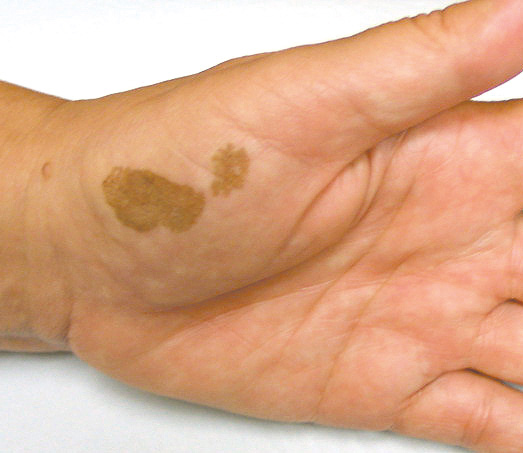CORRECT DIAGNOSIS:
Notalgia Parasthetica
DISCUSSION:
Notalgia Parasthetica has been referred to in the past as many terms, “puzzling posterior pigmented pruritic patches, peculiar spotty pigmentation, or hereditary localized pruritis.” All these terms refer to a neuropathy involving the dorsal primary divisions of spinal nerves. Notalgia Parasthetica is the specific, predominantly sensory, neuropathy involving the posterior rami of the second through the six of the dorsal nerves.
Although thought to be an unusual medical phenomenon, studies show it is more prevalent than previously thought. There may be a hereditary component involved as well. Patients have various complaints. Pruritis may be the predominant complaint, however, patients have stated that they have felt tingling, formication, burning, and hyperalgesia with tenderness over the spinous process. The parenthetic area is well-circumscribed on neurologic examination but may or may not be visible to the naked eye as a tan or brown patch. Patients can complain of a sensory loss in this area [pressure, light touch, and temperature] and its peripheral nerve distribution. Notalgia Parasthetica is usually seen as an isolated idiopathic phenomenon, but in some cases, a traumatic cause is found.
On physical exam, a pigmented patch localized to the area of pruritis or paresthesia is often found. Sometimes no patch is present. An area of wear may be found on the patient’s shirt. Sensation to light touch, temperature, vibration, and two-point discrimination may be normal or abnormal. Hyperesthesia to pinprick may be noted. A decreased sweating response may be noted. Neurologic findings are not necessary for making the diagnosis. The most common locations for these findings are on the left or right posterior upper thorax, medial to the scapula.
Pathology seen on skin biopsies have mixed results, including normal skin and appendages, increased basal cell layer melanin deposition, and perivascular collections of melanophages in the papillary dermis. Necrotic keratinocytes are a uniform finding on H and E stained biopsy. Congo red stain is negative for amyloid.
Treatment shows some success, but often recurrences do occur. Topical capsaicin has been effective but not on a permanent basis. Local anesthetics and corticosteroids may be helpful. The mechanism of action is to stabilize neural membranes and suppress ectopic neural pacemaker activity. Some studies have been done using paravertebral blocks in the region to provide remission. We have added a new modality of treatment to our patient population. Osteopathic manipulative therapy of the thoracic region T2-T6 has been done. Using muscle energy, counterstrain, and high velocity-low amplitude to relieve nerve entrapment and decrease the excitability of the neural pacemaker activity is being tried.
The differential diagnosis for Notalgia Parasthetica includes PIH, LSC, macular amyloidosis, fixed drug reaction, and Hansen’s disease. A careful history and skin biopsy will help to determine what your diagnosis is.
TREATMENT:
The actual treatment for this patient:
Our patient was treated with Luxiq foam BID without relief. He was then treated with Pramasone Lotion TID which relieved the pruritis. At that same visit, a course of OMM was instituted for a 6 week period. A course of Hydroquinone 4 % cream was added to help with the treatment of the hyperpigmentation. Unfortunately, the patient was lost to follow up after, the third visit.
REFERENCES:
Weber, P., & Poulos, E. (1998). Notalgia parasthetica. Journal of the American Academy of Dermatology, 18(1), 25–30. https://doi.org/10.1016/S0190-9622(98)70377-4 [PMID: 9440258]
Goulder, V., & Toome, H. (1998). Successful treatment of notalgia parasthetica with a paravertebral local anesthetic block. Journal of the American Academy of Dermatology, 38(1), 114–116. https://doi.org/10.1016/S0190-9622(98)70137-7 [PMID: 9436688]
Odom, R. B., Berger, T. G., & Schaffer, J. V. (2000). Andrews’ diseases of the skin (9th ed., p. 64). Philadelphia: W.B. Saunders.




